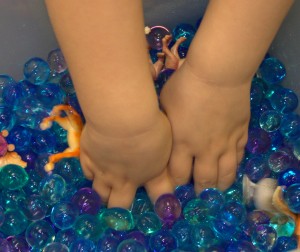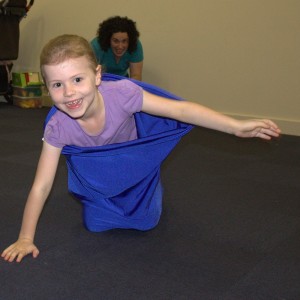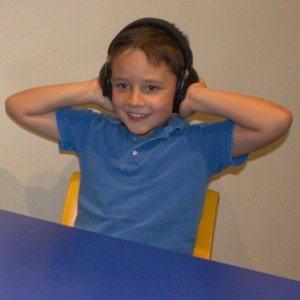 Last week we looked at how kids use their senses to learn about the world, but what happens when this does not work as it should?
Last week we looked at how kids use their senses to learn about the world, but what happens when this does not work as it should?
Sensory Processing Disorder (SPD) is a complex neurological condition that impairs the functional skills of 1 in 20 children. People with Sensory Processing Disorder (SPD) misinterpret everyday sensory information, such as touch, sound and movement. They may feel overwhelmed by sensory information, may seek out sensory experiences or may avoid certain experiences. (www.spdaustralia.com.au)
Dr Jean Ayres defined sensory integration as, ‘the neurological process that organizes sensations from one’s own body and from the environment and makes it possible to use the body effectively within the environment” (Ayres, 1989).
Our bodies need to:
- take in sensory information
- interpret or make sense of this information
- process the information into a response
- adapt to the information
For example:
If we have developed our ability to integrate information from our senses we can:
- hear a repeated noise
- interpret the noise as a ball bouncing
- process the information to understand that Sam is playing basketball outside
- choose to ignore the information and return to what we were doing
 Children with learning and developmental issues and children with ASD often have difficulty processing information from their senses. This can make it challenging for them to learn, focus and take part in certain activities and may effect social interactions and behaviour.
Children with learning and developmental issues and children with ASD often have difficulty processing information from their senses. This can make it challenging for them to learn, focus and take part in certain activities and may effect social interactions and behaviour.
When children have difficulties with sensory integration they may be over or under sensitive to the information, and they may have difficulty interpreting, processing or adapting to the information.
For example if they are under-sensitive they may not be aware of the sound of the basketball. This does not mean there is something wrong with their hearing, rather they find it hard to pay attention to unexpected sounds when they are attending to something else. This is not a problem with the basketball example but it may mean they are not aware when they are spoken to by a parent or teacher if they are focused on something else.
If they are over-sensitive they may be uncomfortable or even distressed by the sound of the basketball even if it is not unusually loud.
If they have trouble interpreting the sound they may not understand what the sound is, or where it is coming from and this can also be distressing.
If they have trouble processing the sound they may not be able to ignore the sound and return to focusing on what they were doing.
 So children with SPD may:
So children with SPD may:
- have difficulty noticing important sensory information
- have difficulty understanding information from their senses
- have difficulty responding appropriately to important sensory information
- have difficulty ignoring unimportant sensory information
Children may be described as sensory seekers when they under react to sensory information. They may seek stimulation to "wake up" their under active senses or to get the input they need.
Children may be described as sensory avoiders when they are over sensitive to sensory input and over react or avoid this because it is uncomfortable, overstimulating, or even overwhelming or distressing. Sometimes this can lead to emotional meltdowns.
The behaviours children show depend on which senses are over and under sensitive. Some children are over sensitive with some senses and under sensitive to others. For example they may be oversensitive to sound, but under-sensitive to touch and so become upset by loud noises but like to touch and explore different touch sensations, such as messy play.
Children who are sensory seekers may:
- put things in their mouth
- lick or sniff things
- seek out certain textures such as silky, smooth or gooey items
- enjoy rough and tumble, be rough in play and with others
- seek out movement
- wriggle and fiddle
- make excessive noises
- lack awareness of danger
- touch others excessively and seek physical contact more than others their age
 Sensory avoiders may:
Sensory avoiders may:
- dislike being touched
- feel uncomfortable with some movement based activities such as swings
- be upset by certain noises
- dislike touching certain textures
- avoid messy activities such as painting, gluing and sand play
- be fussy with food and clothes
- be upset by some daily activities such as bathing, tooth brushing, hair brushing
- be very specific about tastes, smells, textures and temperatures they can tolerate
- dislike bright lights
- be overstimulated by noisy, crowded, busy or bright places
- run away or hide when overwhelmed
When children cannot process information from their senses easily and effectively this affects their ability to focus, learn and take part in daily activities. It can also affect their social interactions and behaviour.
Occupational therapists can help children with sensory processing difficulties by:
- working with parents to determine which senses are over and under active
- helping parents and teachers to understand each child's unique pattern of sensory processing
- providing strategies to reduce sensory overload at home and school
- determine what activities are calming and focusing for an individual child
- developing strategies to help children manage their senses at home and school
- developing activities to provide sensory stimulation in an appropriate way when children seek stimulation
- developing activities to increase tolerance where children are over sensitive
Related Blog Posts
If you liked this post you may also like:
OT for Everyday
Shopping Minis
Tips for handwriting
A Good Night's Sleep



